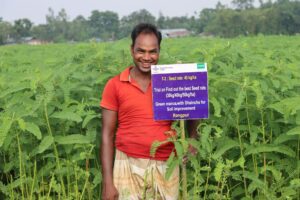A common question but very difficult to answer. Depending on your definition of variety, the answer could be anything from zero to around 500,000 varieties of Oryza sativa (Asian cultivated rice). In the technical sense used by taxonomists (biologists who classify organisms into groups based on evolutionary relationships), descriptions have been published of 14 varieties, but most taxonomists now do not accept any of them as valid taxonomic varieties—so, in this sense, the answer is zero.
Cultivated varieties (abbreviated to “cultivars” to distinguish from the taxonomists’ concept) are something different, but even then we count different numbers for different meanings. Many countries maintain an official list of recognized varieties released for cultivation by farmers. In countries with a legal system for protecting plant breeders’ rights, these varieties may have been subjected to rigorous tests to demonstrate that they are novel, distinct from other varieties, uniform, and stable.
The International Rice Information System (IRIS) recognizes around 5,000 released varieties. The actual number may be greater than 5,000 because no one has systematically collated all countries’ lists. It could also be less because the same genetic variety can be released in more than one country with different entries in IRIS, under the same or a different name.
If you include traditional varieties (also known as farmers’ varieties or landraces), the number goes up markedly. The M.S. Swaminathan Research Foundation in India claims that India alone has 100,000 traditional varieties still in use by farmers around the country, and another 300,000 that have become extinct.
However, the task of counting them becomes very difficult. Traditional varieties predate legal systems of variety protection, and are named only for the farmer’s own convenience, not for legal purposes. Therefore, counting one name does not mean one variety (just like naming people—many different people share the name “Sarah” even though they are unrelated). The same genetic entity may be known by different names in different communities, and the same name may be used for different genetic entities.
In Laos, we have found 3,500 distinct names in use, but many of the names are just generic terms like “black rice” or “glutinous rice,” each covering a multitude of different genetic entities. In a study of 95 samples of black rice from different parts of the country, we found no fewer than 45 distinct varieties—and they can be enormously distinct. For example, leaf color varies from uniformly almost black to variegated to normal green (a green-leaf variety can be called black rice if some other part is black, such as the grain or the husk). So, the 3,500 names in Laos could represent 10,000 or more distinct varieties.
Moreover, unlike modern varieties, traditional varieties are often genetically variable: plants of one variety differ within a field, from field to field, and from year to year. Therefore, even deciding whether or not two seed lots are sufficiently similar to be classified as the same variety is not a trivial task.
So, how do I get 500,000 as an upper limit? It’s more or less a wild guess. India’s 100,000 may be an overestimate, but, even if it is, it’s probably not too wildly out. If the small Southeast Asian countries each have 10,000, India could easily have more than 50,000. A round 80 countries are rice producers. As a large country in the primary center of diversity of rice, it is not out of the question that India could have 10–20% of the worldwide total.
And how many varieties do we have safely conserved in the International Rice Genebank at the International Rice Research Institute? Right now, nowhere near the possible half-million total. The answer is around 100,000. This upper limit is simply the number of accessions that we keep and manage as separate entities. We have not yet begun the challenging task of classifying them into varieties or sorting out which ones, if any, are genetic duplicates.
Our priority now is to document and unravel this fantastic functional diversity of rice so that we can better conserve it and use it for sustainable development in the years to come.
_________________________________________
Dr. Sackville Hamilton is the head of IRRI’s T.T. Chang Genetic Resources Center.









